Global Market Comments
February 2, 2018
Fiat Lux
Featured Trade:
(MORGAN STANLEY TAKES THE LEAD),
(MS), (GS), (GLD), (FCX), (FXE), (FXY),
(REVISITING THE FIRST SILVER BUBBLE),
(SLV), (SLW)
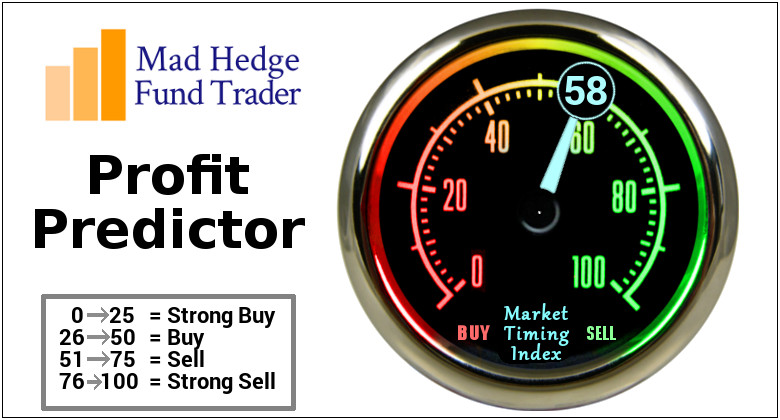
Global Market Comments
February 2, 2018
Fiat Lux
Featured Trade:
(MORGAN STANLEY TAKES THE LEAD),
(MS), (GS), (GLD), (FCX), (FXE), (FXY),
(REVISITING THE FIRST SILVER BUBBLE),
(SLV), (SLW)

It's a good thing that the #MeToo movement wasn't around 35 years ago. For if it was, Morgan Stanley would have been publicly humiliated in the press daily.
The firm was an "old boy" network on steroids. Employees with skirts definitely worked overtime in those prehistoric days.
However firms evolve over the vast expanse of time. Back then, Morgan Stanley was a 1,000 man private partnership hidden away in the old General Motors building on Avenue of the Americas. Today it is a 50,000 member global behemoth bang on Times Square.
The share price has changed a bit too. The average cost of my original partnership shares is 25 cents. They closed at $57 today.
And like Warren Buffet, I never sold my shares so I wouldn't have to pay the capital gains taxes. In fact, my shares cost far less than the company's quarter stock dividend is today.
It wasn't always like this. Morgan drank the Kool-Aide big time during the 2000's real estate bubble. When the bill came due the firm almost went under, with the stock trading down to $5 (which was still 20 times more than my cost). Only a government bailout in the form of the TARP kept my former partners from losing everything.
The Morgan Stanley of today is a shadow of its former self in other ways. There are no more wild practical jokes, BSD's, Masters of the Universe, or Liar's Poker.
I can't imagine the heads of the various equity trading desks meeting at my Sutton Place coop apartment to play high/low poker once a week, as they once did for years.
No one bets the ranch anymore. Morgan Stanley has become boring. However, boredom has a silver lining as it also brings stability, and stock investors absolutely love stability. As incredible as it may sound, Morgan Stanley has become the safe play on Wall Street.
While investors considered the immense trading profits the firm once made as coming out of a black box, fee-based earnings are predictable and reliable as a coupon stream.
You can see this newfound boredom in the firm's employee compensation. A decade ago it was 78% of investment banking revenue, compared to only 18% now. In my day, the janitor wouldn't work for that.
You can thank my late mentor, Barton Biggs, for planting the seeds of the modern firm in the early 1980's. For it was he who founded the firm's fee-based asset management division which is the great wellspring of profits today. Since 2005, Wealth Management's share of profits has leapt from almost nothing during my tenure to 25% to 45% now.
Mortgage loans to customers collateralized by their shareholdings is currently the second largest source of profits. These didn't even exist in my day (Lou Ranieri at Salomon Brothers had the lock on this business back then).
Morgan Stanley has learned some hard lessons along the way. It was forced by the Dodd-Frank financial regulation act to massively recapitalize. No more 40:1 leverage. 10:1 is much safer.
As a result, its capital position has more than doubled from $35 billion during the dark days of the 2008 crash to $77 billion today. Profit margins are the highest since the Dotcom Bubble top in 1999. The firm is even now crafting products and services aimed at the growing band of wealthy Millennials. Sobriety is in.
Goldman Sachs on the other hand has stuck to the old wild west ways. Its earnings remain volatile, as several recent disappointing quarters of bond trading losses have attested to. The firm is now significantly smaller than Morgan, and its share price has been punished accordingly, lagging the heady appreciation of Morgan shares.
Here's the main reason I love my old firm. It is in the catbird seat for what I call the "Exploding Deficit" trade, whereby all future investment is driving by the prospect of rising inflation.
Banks are absolutely in the sweet spot for this strategy, as are gold (GLD), commodities (FCX), and foreign currencies (FXE), (FXY).
Add all this up and you have my explanation for sending out a Trade Alert for a long position in Morgan Stanley yesterday. It won't be the last one.
As for those poker nights, I think some of you guys out there still owe me a couple of grand.

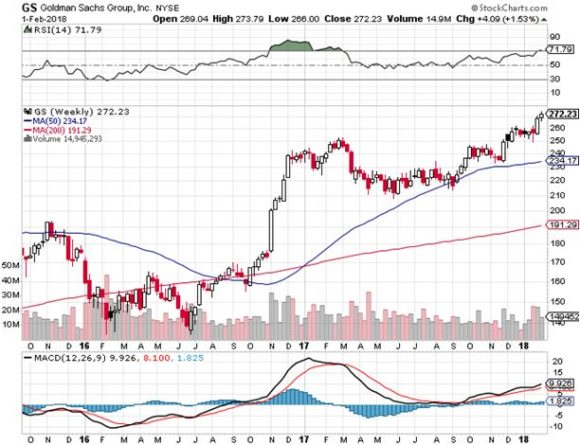
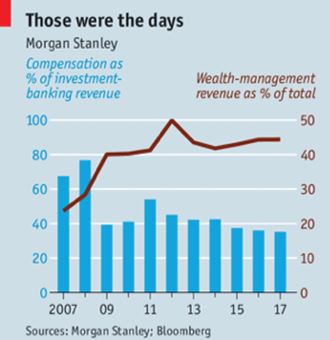

Global Market Comments
February 1, 2018
Fiat Lux
Featured Trade:
(THE DEATH OF THE HIGH YIELD INVESTMENT),
(TIPS), (HYG), (JNK), (TLT), (AJX), (CIM), (BAB),
(EPD), (MMP), (NS), (KMI), (OKE), (WHF), OKE),
(TESTIMONIAL)
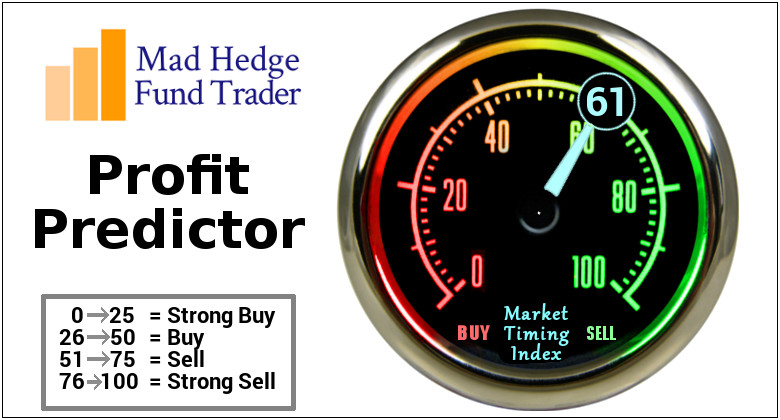
Interest rates have been going down for so long that you have to be as old as I am (66) to remember what interest rate??risk is.
Despite more than $200 billion worth of inflows into bond funds in 2017, most delivered total returns of near zero.
Now get ready for the shocker: 2018 will be the first time in three decades where bond investors see actual LOSSES!
For the fat is about to hit the fire. Sometime in 2018 both the Federal Reserve AND the European Central Bank will be engaged in quantitative tightening at the same time. You can almost hear that great sucking sound already.
Which begs the question, after visiting this well for so long, what are investors in traditional high yield plays supposed to do during a period of consistently rising interest rates?
It is a conundrum.
The writing is certainly on the wall. Since the beginning of this year the yield on the ten-year Treasury bond has erupted from 2.41% to 2.74%.
Our double short position in bonds (TLT) has been the most consistently profitable trade so far in 2018. It has been a true rout for the ages.
No matter where you look in fixed income land, be it ten-year Treasury bonds, corporates, and the 30-year conventional fixed rate mortgage, rates have just blasted through to four-year highs.
Do not give up all hope. There are a number of ways fixed income players can earn their crust of bread in a rising rate market, but you may have to go to a natural history museum to find them. When was the last time someone recommended you buy TIPS (Treasury Inflation Protected Securities)? The Jurassic Period?
Also, some of these instruments are anything but plain vanilla and may require more than the usual amount of due diligence.
The principal goal for bond holders in a rising rate environment is to protect their principal through shortening duration. A six month or one-year maturity will carry infinitely lower risk than a 10 or 30 year one.
It the wheels fall off the debt market, and they are in the process of doing exactly that, you just collect your interest and principal when the paper matures and be gone.
Another big priority is to shift from fixed rate bonds to floating rate ones. This way, the bond's interest payments rise with interest rates, thus protecting the value of the underlying principal.
Some 30 years ago, the last time interest rates were rising, there was an entire cottage industry devoted to issuing and analyzing just such instruments. Now it is a shadow of its former self. But there are still a few around and I will try to analyze them for you one by one.
TIPS-
The total return on Treasury Inflation Protected Securities is tied to the Consumer Price Index. When inflation rises, the value of your TIPS rise.
The problem now is that while interest rates are rising sharply, inflation is moving at a snail's pace, so no protection here. When it does, your TIPS should perform.
Junk Bonds-
Buying the junk bond ETF's like (JNK) and (HYG) has been a traditional means through which investors reached for yield. Unfortunately, they have so closely tracked the stock market in recent year they now offer no downside protect from a stock market rout.
They are also just as overvalued as shares, with the average junk yield of 5.2% now at a record low, some 246 basis points over ten-year Treasury bonds. Better to stay away in droves.
REITS-
Real Estate Investment Trusts have been a perennial high yielders favorite. However, these are highly leveraged entities, so when their cost of money rises they take a big hit. This is why I have been begging readers to bail on their REIT's for the past year.
However, there are still a few specialized REIT's that make sense. REIT's that invest predominantly in floating rate securities possess the tax advantages of normal REIT's but lack the principal risk.
One of these is Great Ajax (AJX), which invests in pools of mortgage securities, and boasts an 8.6% dividend yield. Because REIT's generally are so out of favor you can buy this at a 10% discount to net asset value. Chimera Investment (CIM) has a similar set up.
Taxable Municipal Bonds-
We all know the wonders of tax free local municipal bonds. However, in a falling tax rate environment this are much less valuable than in the past.
In that case you want to move to taxable municipal bonds which offer much higher yields.
The great thing here is that even taxable muni bonds have far lower default rates than normal corporate bonds which aren't reflected in the yields.
And you can sidestep the taxability by only holding the securities in one of your tax-free retirement accounts, of which I'm sure you all have many.
The PowerShares Taxable Municipal Bond Portfolio (BAB) has a 4% yield and a portfolio of single "A" to double "AA" munis, which is really the same as having a triple "AAA" corporate bond portfolio.
What about Puerto Rico debt you may ask, which we all know will never repay all its debts? You can buy such paper, but only if it is insured, which still leaves you a reasonable 4.5% return net of expenses.
Master Limited Partnerships-
With the price of oil expected to remain stable or rise for the next year, an MLP is a pretty good way to reap some safe double digit returns.
MLP's take advantage of specialized tax breaks unique to their industry that allow you to avoid double taxation of corporate profits and dividend payouts, thus offering much higher returns than normal companies.
The catch is that as partnerships you must include a form k-1 with your tax return for each one of these you own. If you have a lot your return will start to look like the New York telephone book (if they still have those) or Sears catalogue (oops, they're gone too).
Here, the research really pays off. Knowing the quality of the assets underlying each partnership is immensely valuable. I'll give you three good ones: Enterprise Products Partners (EPD), Magellan Midstream Partners (MMP), and NuStar Energy (NS). If you'd rather avoid the tedium of k-1's you can go with Kinder Morgan (KMI) or Oneok (OKE).
However, if oil goes into a swan dive again, as it will in the next recession, you don't want to be anywhere near the MLP space. Many of these went bankrupt in the last down cycle (remember LINN)?
Business Development Companies-
BDC's are securitized direct lenders to small and medium sized businesses. This is a great business model because you can lend at very high 8%-10% interest rates to mezzanine level companies, while getting almost unlimited access to their books to quantify your risk. Most of these loans are extended with floating rates, mitigating your interest rate risk
WhiteHorse Finance (WHF) is in this business, as is OFS Capital (OFS). The trick is to avoid BDC's the concentrate too much risk with a single borrower. You also want to avoid this business when we go into a real recession. Many of these drop like flies during the last turn down, although that was a once in a century event.
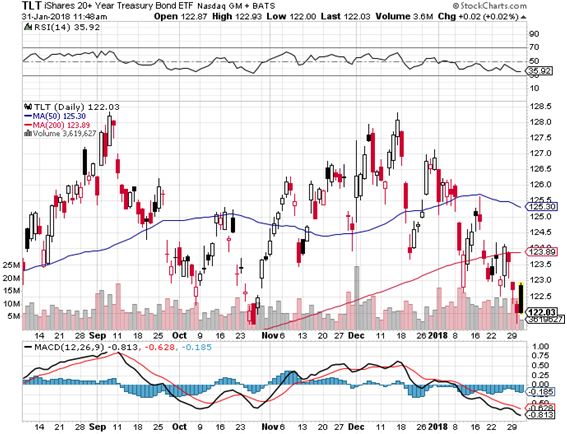
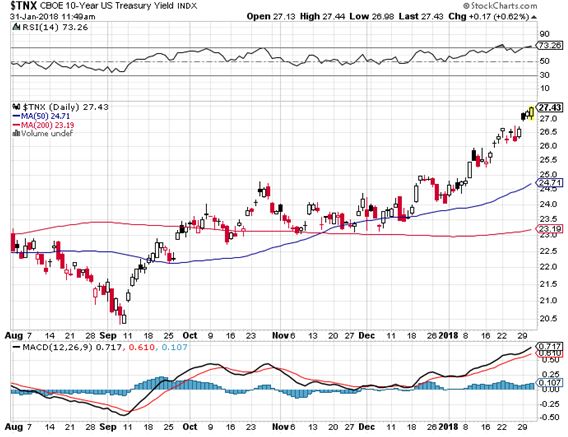
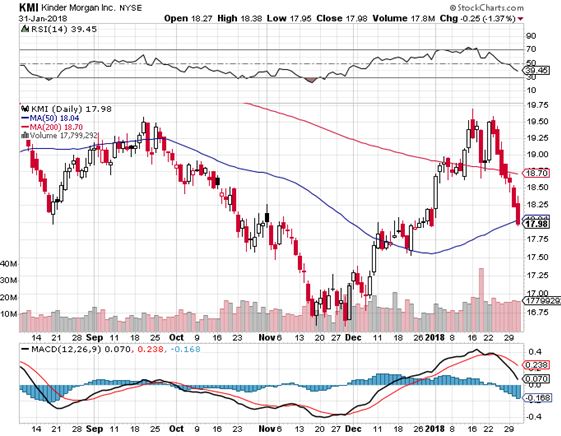
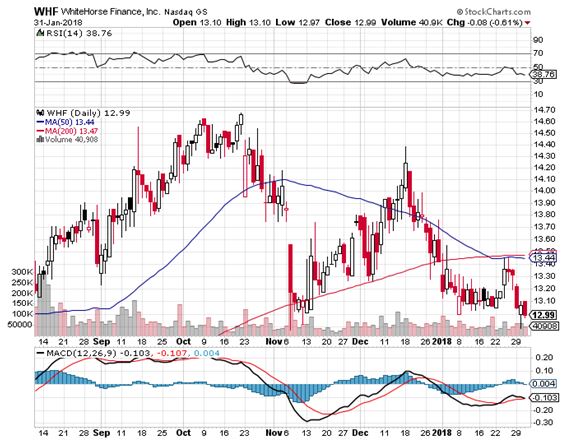

Global Market Comments
January 31, 2018
Fiat Lux
Featured Trade:
(WHO THE GRAND NICARAGUA CANAL HAS WORRIED),
(SCAM OF THE MONTH)
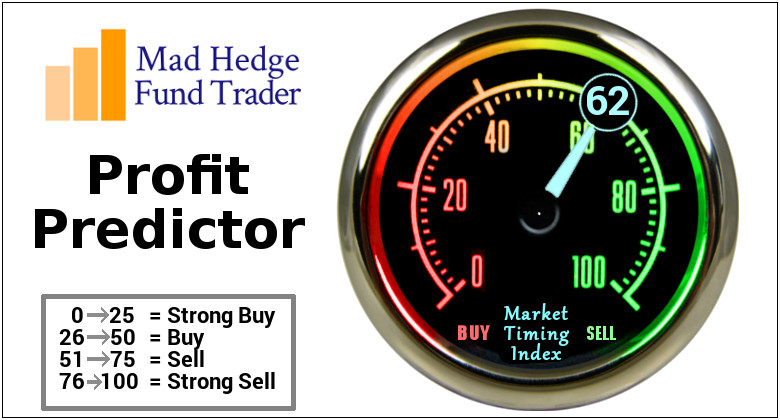
Global Market Comments
January 30, 2018
Fiat Lux
Featured Trade:
(JOIN THE MAD HEDGE TECHNOLOGY LETTER PRODUCT LAUNCH)
(THE I-WORD IS BACK WITH A VENGEANCE),
($TNX), (GS), (GLD), (USO), (XLU), (SPG), (TLT),
(BETTER BATTERIES HAVE BECOME BIG DISRUPTERS)
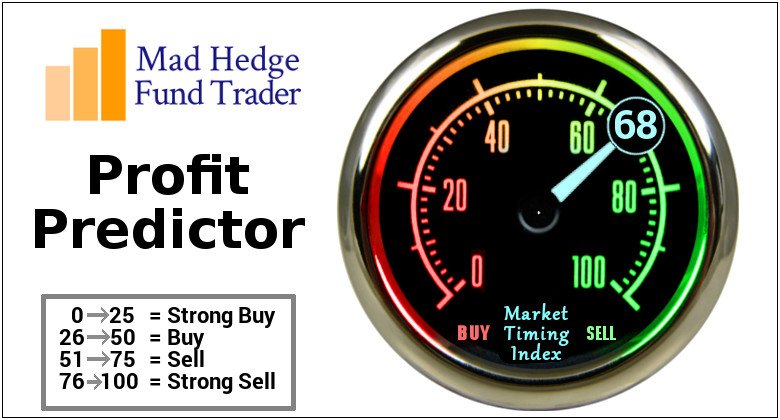
Come join me for the launch of the Mad Hedge Technology Letter, which will take place on Wednesday, January 31 at 12:00 EST.
I will be presenting a broad overview of the entire technology sector, from artificial intelligence to social media.
Technology has become the seminal investment theme of our lifetimes. Since WWII, technology companies have rocketed from 1% of US stock market capitalization to 25%, and they're now on their way to 90%. Eventually all companies will become tech ones, or cease to exist.
Over 50% of retail sales took place online in 2017, with one company, Amazon, accounting for half. The earnings of tech companies are growing 50% faster than non-tech ones. The technology sector has been the top performer since the 2009 stock market bottom.
In view of these developments you would be crazy NOT to invest a major portion of your retirement funds in technology stocks.
I will wrap up the webinar with a listing of the many services provided by the new Mad Hedge Technology Letter. I will also include a one-time only special discount offer for inaugural subscribers only.
Questions will be welcome through a live chat box.
I look forward to seeing you there.
John Thomas
CEO & Publisher
The Mad Hedge Technology Letter

They say a picture is worth a thousand words.
Take a look at the four charts below for the ten-year Treasury bond yield ($TNX), Goldman Sachs (GS), Gold (GLD), and oil (USO), and they explain everything that is going on in financial markets right now. In fact, they could all be the identical chart.
They all show that after building very long multiyear bases they are breaking out to the upside. This almost always heralds successive new highs, if not new all-time highs.
These charts also all have another thing in common. They are all inflation plays. Yes, after a decade long hiatus, the I-word is back.
Of course, we haven't seen runaway price increases throughout the economy yet. Most of the inflation we have seen so far has been in asset prices, both in paper and the hard kind in real estate.
No, the charts are suggesting that while real inflation is not here yet, it may be just round the corner. And they may be right.
Look at the real estate sector of any major newspaper right now and it has shrunk to near invisibility. That's because homeowners have pulled their residences off the market, paring back both the listings and the advertising that go along with them.
They are afraid that if they sell their dwellings in these frenetic markets they won't be able to replace it with another one, except at much higher prices. Real estate has in effect become a one-way market.
I'll tell you where to find another one-way market and that's in stocks. With the Dow average up 7% so far in January, we have seen the most aggressive start to a new year in three decades.
Investors are similarly afraid that if that take profits they will have to buy back in at elevated levels. So they aren't selling.
It isn't just inflation that is driving investors into hard asset and rising interest rate plays. They are buying them purely because they are cheap. As I have said time and again, you should only buy cheap stuff in expensive markets. These are the asset classes that have languished for years.
If you have any quibbles with my logic, take a peek at the inverse stock plays and you will be horrified. This would include the (TLT) itself, REITS (SPG), and utility stocks (XLU), all sectors that suffer from rising interest rates and inflation.
These are some of the best shorts in the market right now. If you own them, better to arrange a going away party as quickly as possible.

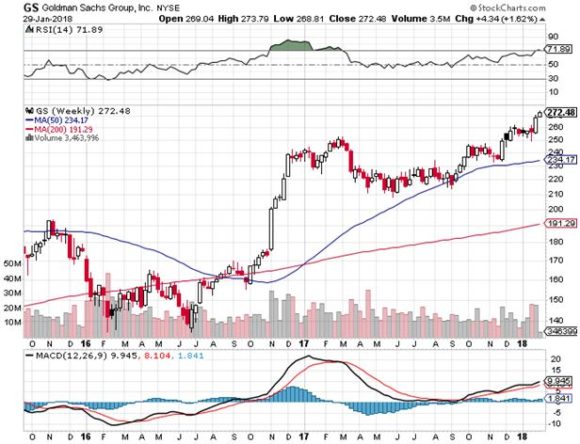
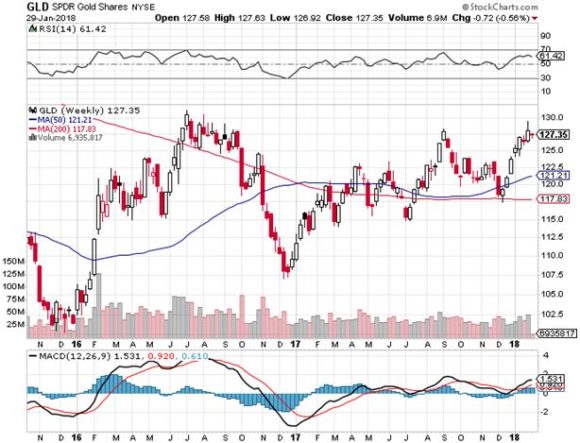

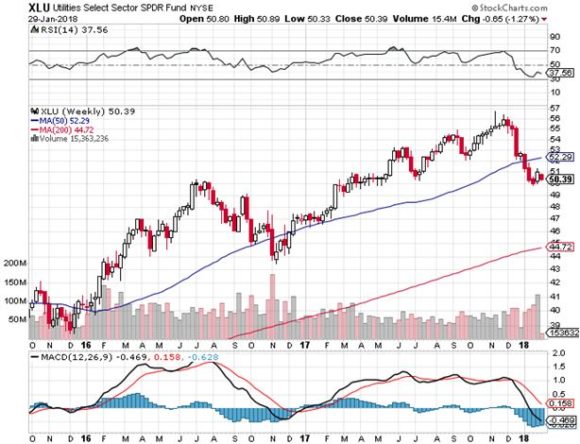
Global Market Comments
January 29, 2018
Fiat Lux
Featured Trade:
(MARKET OUTLOOK FOR THE WEEK AHEAD, or RELIVING 1918),
(SPY), (GLD), (NEM), (TLT), (FCX), (BAC), (CAT),
(THE BIPOLAR ECONOMY),
(TESTIMONIAL)

Boy I never thought I’d relive 1918 again. We get both a bull market AND a flu epidemic.
The extent of the plague out here in California is nothing less than of Biblical proportions. Whole school districts are shutting down, people aren’t showing up for meetings, and daily newsletters are arriving at half their normal length, or not at all.
Over 100 have died from the flu in the Golden State, but not me! I guess I’m just too mean to die. The virus just lands on me and shrivels away from neglect.
Some $33.2 billion poured into equity funds the previous week, an all-time high. Party while you can, for it’s the next generation that’s going to have to pay the bill.
The markets are increasingly resembling the final melt up of the Dotcom boom, and we all remember how that one turned out! Of the eight blowout Januaries that have occurred in stock market history, six went on to deliver 20% gains. One can only hope.
The US wants a weak dollar. No! It wants a strong dollar. Weak, strong, weak strong, help! Clearly the government is of two minds over the direction of the greenback, with the president and the Treasury secretary painting dueling scenarios.
The foreign exchange markets are voting with their feet, taking the dollar down 10% in a year. Foreign capital flight from the US in fear of coming political instability is clearly an issue, as is Chinese dumping of its once $1 trillion holdings of US paper. Emerging markets, small caps, and Boeing (BA) and Caterpillar (CAT) love it.
The last time the US pursued an openly weak US dollar policy was under Nixon. As you may recall, gold soared from $34 to $900 after Tricky Dick took the US off the gold standard.
Not all is perfect here in Silicon Valley, with Apple (AAPL) performing a 4% swan dive, triggering my first stop loss of 2018. It won’t be the last.
First, the European Community announced a $1.25 billion antitrust fine against Apple’s chip supplying partner, QUALCOM (QCOM). Then Apple got hit by a raft of analyst downgrades for second quarter iPhone sales.
The third nail in the coffin for this trade was a presidential comment that he favored a strong dollar. This has the unfortunate effect of immediately devaluing about half of Apple’s earnings and accounted for the $3 plunge we got on Thursday.
Still, better to dig out a small hole instead of a deep one. Never underestimate the stupidity of other investors, especially those who read the wrong newsletter.
Our first report of Q4 GDP came in at a moderate 2.6 %, with housing showing overwhelming the greatest rate of growth at 11.6%. Gotta love all those positive housing pieces I have been sending you for the last several years.
As for the Mad Hedge Fund Trader Alert Service, we keep grinding up from one new all-time high to the next. We are up 2.40% in January, with a trailing 12 month return of 53.49%. Our eight year profit stacks up to 278.87%.
I have been going pedal to the metal on the debt explosion theme, with a double short in Treasury bonds (TLT), double longs in gold (GLD), (NEM), and a long in commodities (FCX).
And since were are clearly bored here with loads of time on our hands to think up mischievous thoughts, we are rolling out our new Mad Hedge Technology Letter in the coming week to take up the slack.
This week will be all about jobs data, which roll out in rapid succession from Wednesday morning.
We are now into Q4 earnings season so those should be the dominant data points of the coming weeks.
On Monday, January 29, at 10:30 AM, the week kicks off with the December Chicago Dallas Fed Manufacturing Survey, a read on business conditions in the Lone Star State. Lockheed martin (LMT) reports earnings.
On Tuesday, January 30 the Fed’s Open Market Committee Meeting starts a two-day meeting. At 9:00 AM EST a new S&P 500 Case Shiller CoreLogic National Home Price Index is released. Advanced Micro Devices (AMD), Pfizer (PFE), and McDonald’s (MCD) report earnings.
On Wednesday, January 31, at 10:00 AM EST, we get the first of the big jobs numbers with the January ADP Employment Report. Boeing (BA) and Microsoft (MSFT) report earnings.
At 2:00 PM we get the Fed decision on interest rates. The outlier is for them to announce a surprise 25 basis point rise to heat off a superheating economy.
Thursday, January 25 leads with the 8:30 EST release of the Weekly Jobless Claims. At 9:45 AM we learn the PMI Manufacturing Index, a leading indicator of private sector business activity. The weekly EIA Petroleum Status Report is out at 11:00 AM EST. Alphabet (GOOGL) and Apple report earnings.
On Friday, January 26 at 8:30 AM the January Nonfarm Payroll Report it out.
Then at 1:00 PM, we receive the Baker-Hughes Rig Count, which has started going ballistic. ExxonMobile (XOM) reports earnings.
As for me, I'll be taking off for the Wynn Hotel in Las Vegas this weekend, where I understand a large number of rooms have suddenly become available.
But $7.5 million for a manicure? It sounds a little steep to me. I can get them at home for $15. I guess location is everything, and it depends who’s asking!
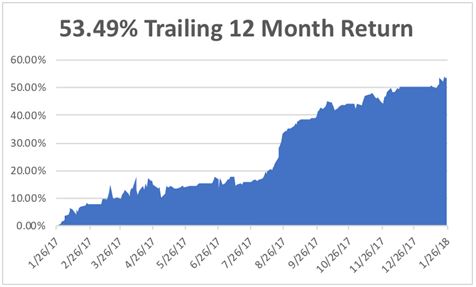
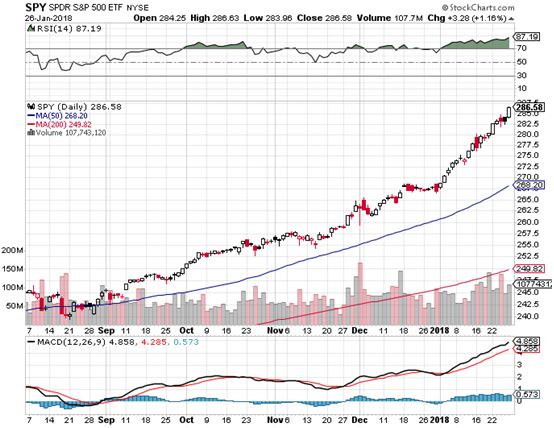



Legal Disclaimer
There is a very high degree of risk involved in trading. Past results are not indicative of future returns. MadHedgeFundTrader.com and all individuals affiliated with this site assume no responsibilities for your trading and investment results. The indicators, strategies, columns, articles and all other features are for educational purposes only and should not be construed as investment advice. Information for futures trading observations are obtained from sources believed to be reliable, but we do not warrant its completeness or accuracy, or warrant any results from the use of the information. Your use of the trading observations is entirely at your own risk and it is your sole responsibility to evaluate the accuracy, completeness and usefulness of the information. You must assess the risk of any trade with your broker and make your own independent decisions regarding any securities mentioned herein. Affiliates of MadHedgeFundTrader.com may have a position or effect transactions in the securities described herein (or options thereon) and/or otherwise employ trading strategies that may be consistent or inconsistent with the provided strategies.
This site uses cookies. By continuing to browse the site, you are agreeing to our use of cookies.
OKLearn moreWe may request cookies to be set on your device. We use cookies to let us know when you visit our websites, how you interact with us, to enrich your user experience, and to customize your relationship with our website.
Click on the different category headings to find out more. You can also change some of your preferences. Note that blocking some types of cookies may impact your experience on our websites and the services we are able to offer.
These cookies are strictly necessary to provide you with services available through our website and to use some of its features.
Because these cookies are strictly necessary to deliver the website, refuseing them will have impact how our site functions. You always can block or delete cookies by changing your browser settings and force blocking all cookies on this website. But this will always prompt you to accept/refuse cookies when revisiting our site.
We fully respect if you want to refuse cookies but to avoid asking you again and again kindly allow us to store a cookie for that. You are free to opt out any time or opt in for other cookies to get a better experience. If you refuse cookies we will remove all set cookies in our domain.
We provide you with a list of stored cookies on your computer in our domain so you can check what we stored. Due to security reasons we are not able to show or modify cookies from other domains. You can check these in your browser security settings.
These cookies collect information that is used either in aggregate form to help us understand how our website is being used or how effective our marketing campaigns are, or to help us customize our website and application for you in order to enhance your experience.
If you do not want that we track your visist to our site you can disable tracking in your browser here:
We also use different external services like Google Webfonts, Google Maps, and external Video providers. Since these providers may collect personal data like your IP address we allow you to block them here. Please be aware that this might heavily reduce the functionality and appearance of our site. Changes will take effect once you reload the page.
Google Webfont Settings:
Google Map Settings:
Vimeo and Youtube video embeds:
